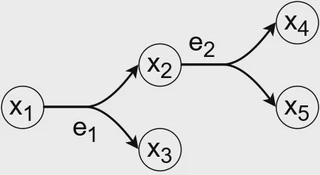Finding (s,d)-Hypernetworks in F-Hypergraphs is NP-Hard
Finding (s,d)-Hypernetworks in F-Hypergraphs is NP-Hard
 Image credit: Loïc Miller
Image credit: Loïc MillerAbstract
We consider the problem of computing an (s,d)-hypernetwork in an acyclic F-hypergraph. This is a fundamental computational problem arising in directed hypergraphs, and is a foundational step in tackling problems of reachability and redundancy. This problem was previously explored in the context of general directed hypergraphs (containing cycles), where it is NP-hard, and acyclic B-hypergraphs, where a linear time algorithm can be achieved. In a surprising contrast, we find that for acyclic F-hypergraphs the problem is NP-hard, which also implies the problem is hard in BF-hypergraphs. This is a striking complexity boundary given that F-hypergraphs and B-hypergraphs would at first seem to be symmetrical to one another. We provide the proof of complexity and explain why there is a fundamental asymmetry between the two classes of directed hypergraphs.
Type
Publication
In Information Processing Letters 184 (2024): 106433